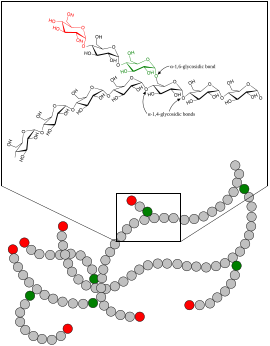Glycogenolysis



Glycogenolysisis the breakdown ofglycogen (n)toglucose-1-phosphateand glycogen (n-1). Glycogen branches arecatabolizedby the sequential removal of glucose monomers viaphosphorolysis,by the enzymeglycogen phosphorylase.[1]
Mechanism[edit]
In the muscles, glycogenolysis begins due to the binding ofcAMPtophosphorylase kinase,converting the latter to its active form so it can convert phosphorylase b tophosphorylase a,which is responsible for catalyzing the breakdown of glycogen.[2]
The overall reaction for the breakdown of glycogen to glucose-1-phosphate is:[1]
- glycogen(n residues)+ Pi⇌ glycogen(n-1 residues)+ glucose-1-phosphate
Here,glycogen phosphorylasecleaves the bond linking a terminal glucoseresidueto a glycogen branch bysubstitutionof aphosphorylgroup for the α[1→4] linkage.[1]
Glucose-1-phosphate is converted toglucose-6-phosphate(which often ends up inglycolysis) by the enzymephosphoglucomutase.[1]
Glucose residues are phosphorolysed from branches of glycogen until four residues before a glucose that is branched with a α[1→6] linkage.Glycogen debranching enzymethen transfers three of the remaining four glucose units to the end of another glycogen branch. This exposes the α[1→6] branching point, which ishydrolysedbyα[1→6] glucosidase,removing the final glucose residue of the branch as a molecule of glucose and eliminating the branch. This is the only case in which a glycogen metabolite is not glucose-1-phosphate. The glucose is subsequently phosphorylated to glucose-6-phosphate byhexokinase.[1]
Enzymes[edit]
- Glycogen phosphorylasewithPyridoxal phosphateasprosthetic group
- Alpha-1,4 → Alpha -1,4 glucan transferase
- Alpha-1,6-glucosidase
- Phosphoglucomutase
- Glucose-6-phosphatase(absent in muscles)[3]
Function[edit]
Glycogenolysis takes place in the cells of themuscleandlivertissues in response to hormonal and neural signals. In particular, glycogenolysis plays an important role in thefight-or-flight responseand the regulation of glucose levels in the blood.
Inmyocytes(muscle cells), glycogen degradation serves to provide an immediate source of glucose-6-phosphate forglycolysis,to provide energy for muscle contraction. Glucose-6-phosphate can not pass through the cell membrane, and is therefore used solely by the myocytes that produce it.
Inhepatocytes(liver cells), the main purpose of the breakdown of glycogen is for the release of glucose into the bloodstream for uptake by other cells. The phosphate group of glucose-6-phosphate is removed by the enzymeglucose-6-phosphatase,which is not present in myocytes, and the free glucose exits the cell viaGLUT2facilitated diffusion channels in the hepatocyte cell membrane.
Regulation[edit]
Glycogenolysis is regulated hormonally in response to blood sugar levels byglucagonandinsulin,and stimulated byepinephrineduring thefight-or-flight response.Insulin potently inhibits glycogenolysis.[4]
In myocytes, glycogen degradation may also be stimulated by neural signals;[5]glycogenolysis is regulated by epinephrine and calcium released by thesarcoplasmic reticulum.[3]
Glucagon has no effect on muscle glycogenolysis.[3]
Calcium binds withcalmodulinand the complex activates phosphorylase kinase.[3]
Clinical significance[edit]
Parenteral (intravenous) administration of glucagon is a common human medical intervention indiabeticemergencies when sugar cannot be given orally. It can also be administeredintramuscularly.
Pathology[edit]
See also[edit]
References[edit]
- ^abcdeDL Nelson & MM Cox (2008).Lehninger principles of biochemistry(5th ed.). New York: W.H. Freeman. pp.595-596.ISBN978-0-7167-7108-1.OCLC191854286.
- ^Paredes-Flores MA, Rahimi N, Mohiuddin SS (9 January 2024).Biochemistry, Glycogenolysis.StatPearls Publishing.PMID32119304.
- ^abcdVasudevan DM, S S, Vaidyanathan K (2 June 2016).Textbook of Biochemistry for Medical Students.Jaypee Brothers Medical Publishers Pvt. Limited.ISBN978-93-5465-648-4.
- ^Sargsyan A, Herman MA (2019)."Regulation of Glucose Production in the Pathogenesis of Type 2 Diabetes".Current Diabetes Reports.19(9): 77.doi:10.1007/s11892-019-1195-5.PMC6834297.PMID31377934.
- ^Lodish, et al. (2007).Molecular Cell Biology(6th ed.). W. H. Freeman and Company. p. 658.ISBN978-1-4292-0314-2.
External links[edit]
- The chemical logic of glycogen degradation at ufp.pt
- Glycogenolysisat the U.S. National Library of MedicineMedical Subject Headings(MeSH)

